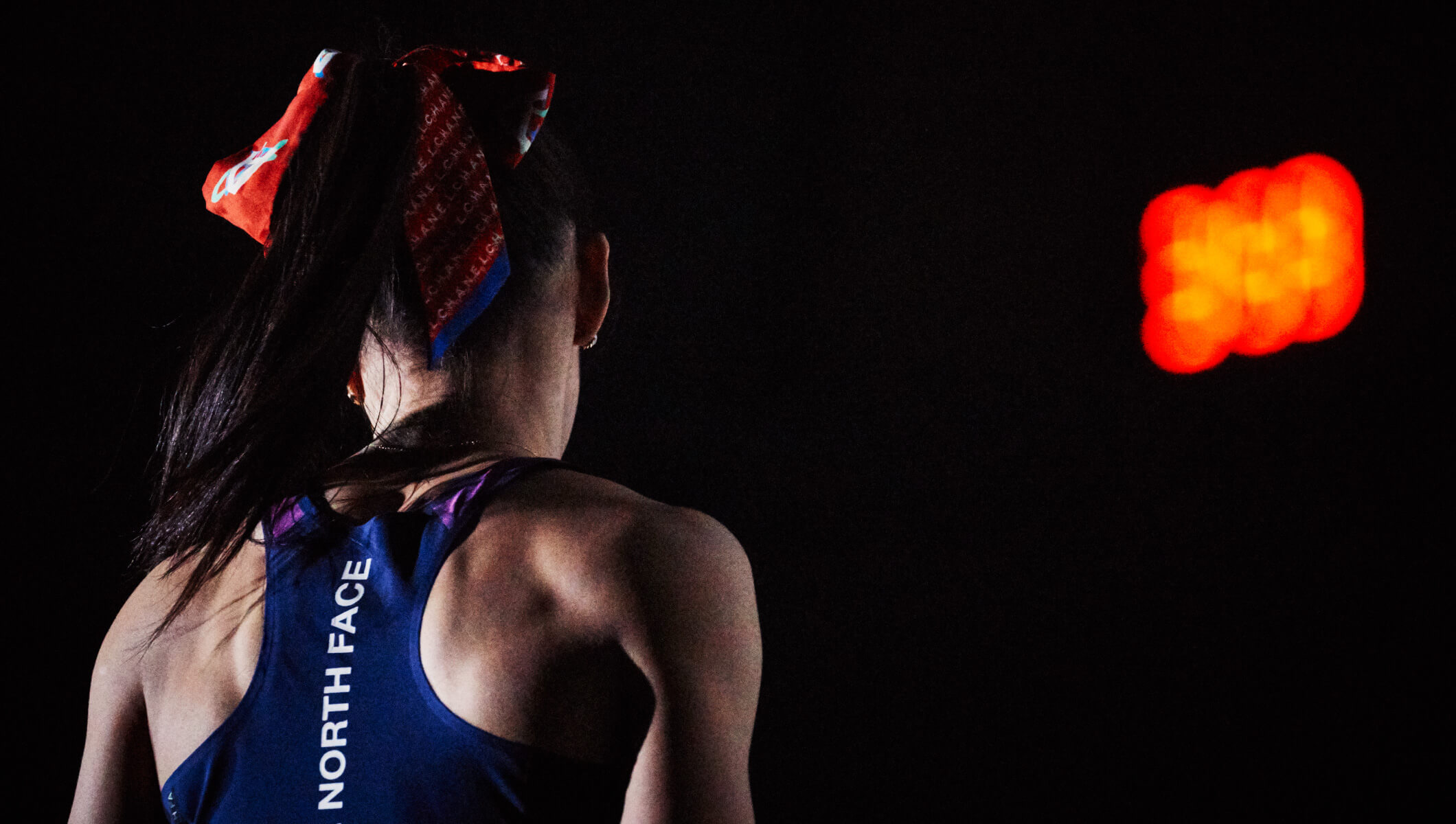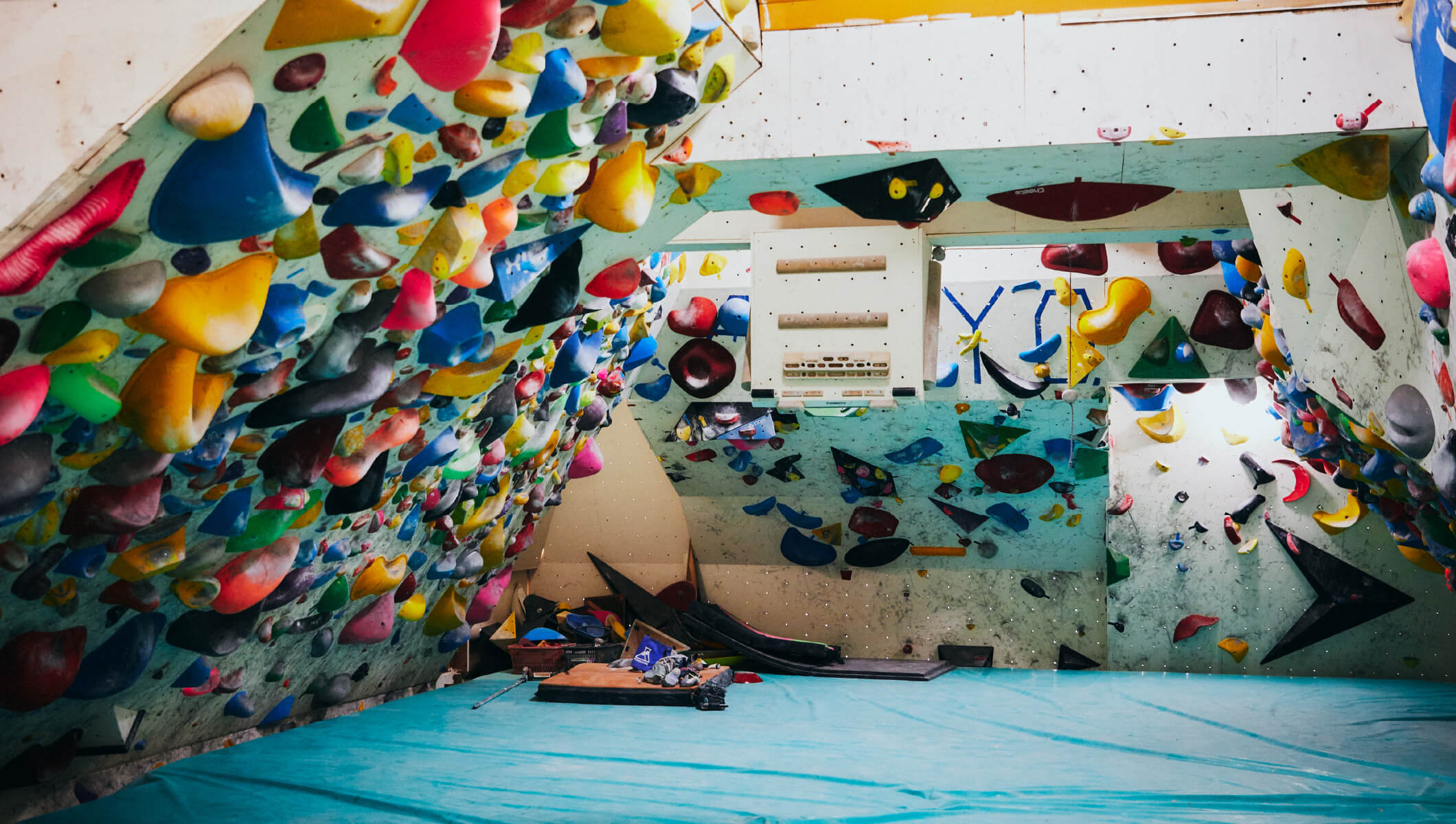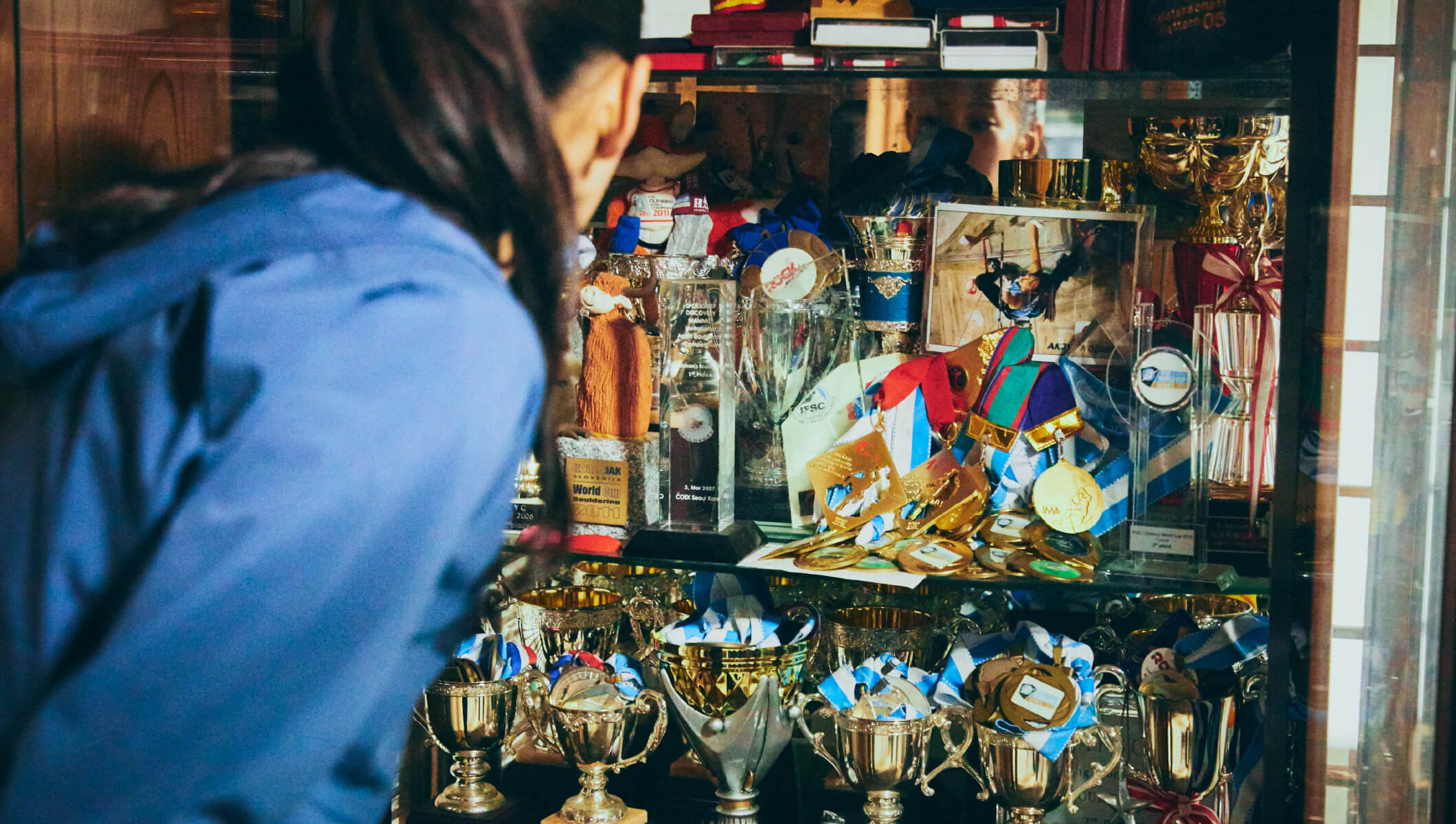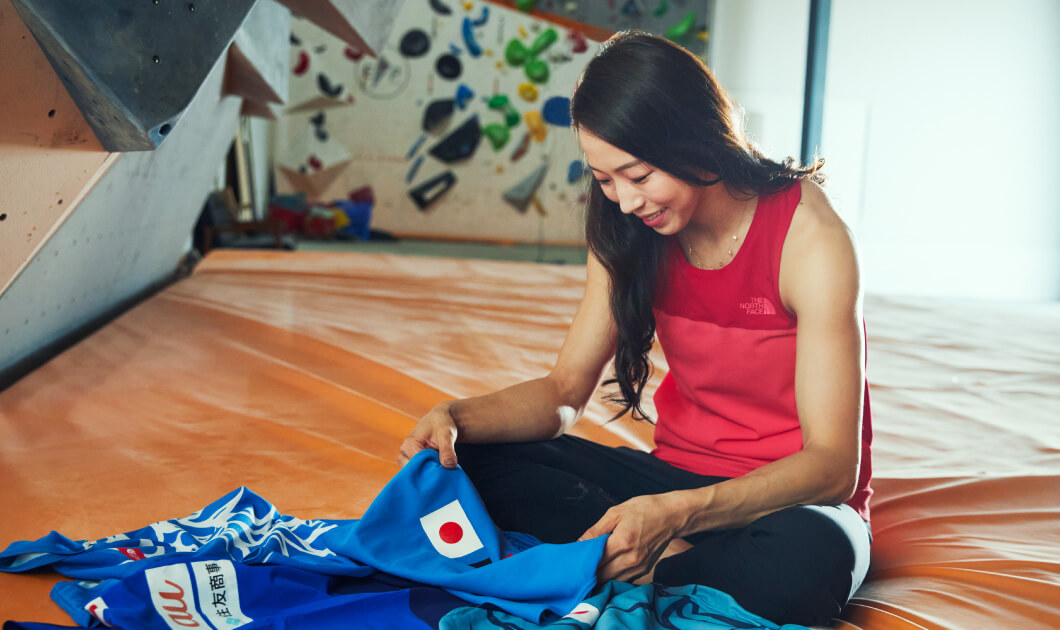
A Childhood Immersed in Climbing in a Converted Cowshed Gym
At the age of 11, Akiyo Noguchi experienced climbing for the
first time on a trip to Guam. Upon returning, her father Kenji
began taking Akiyo and her younger sister and brother to gyms in
Ibaraki prefecture and the nearby city of Tokyo.
“My first
encounter with climbing was a climbing game at an arcade in Guam
during a family trip. Soon after, I started going to a local
gym. I always liked climbing trees as a child and climbing high
places was fun. I think that even then I had strong fingertips—I
remember being happy about being able to take the small holds
that grown-ups were unable to handle and climbing routes that my
father couldn’t.”

Her father Kenji looks back at that time:
“She was such an
active kid at home and pretty bossy to her younger sister and
brother, but once she was outside she was quiet. What her
elementary school teachers would say about her and how she
behaved at home were quite different. She was such a ‘lion at
home and a mouse abroad’ that I was always surprised by her
behavior. Climbing was still a minor sport then and there were
only a few female athletes in elementary school at national
tournaments. Akiyo would make friends her age and always
promised to see them at the next tournament. Because we didn’t
have cell phones back then, she looked forward to each next
meet. At school, however, maybe she was embarrassed to have to
talk about a minor sport, so she didn’t tell too many people
that she was a climber. This is something I found out a while
ago, reading one of her articles.”

The Noguchis were a dairy farming family. There were cowsheds on
the farm and they raised cows during Akiyo’s childhood.
Sometimes she would help with the milking and she would run and
play with her siblings between the cows. She recalls that when
she came home from school, she would ask her mother where to
find her father on the sprawling farm because she loved to watch
him work. When Akiyo started junior high school, her father
suddenly converted an old cowshed into a private bouldering
gym.
“I was on the track and field team during junior high
and after school, and I would take a 30-minute car ride to a
climbing gym in Tsukuba. I think my father couldn’t bear to see
me have to commute to do what I loved and built the gym so that
I could climb at home. He claims he built it for himself but
I’ve never seen him climb [laughs].”

A Father and Daughter’s Challenge at Their First World Tournament
Less than a year after she started climbing, Akiyo won the Youth
Championship, and as she entered junior high she began to really
stand out at competitions in Japan. In 2005, the year she
started high school, she won the first Bouldering Japan Cup at
the age of 16. She would go on to set a record of nine
consecutive wins at this tournament. It was also in 2005 that
she became more conscious of competing on an international
level. She participated in the UIAA World Championships in
Munich as the first representative from Japan in the Lead and
Bouldering sections.
“That tournament was a major turning
point in my competitive career. I had been participating in the
Youth Games since my second year in junior high, so I had
experienced tournaments overseas but there was pressure to wear
the Japanese team uniform and carry the flag. I felt that I
couldn’t fail and became desperate. Before that time, I’d only
trained once or twice a week, but from then on I trained every
day on the wall at home after school. After dinner I went back
to the wall, and in the evening, I went running with my father.”

Taking on this intense regimen and training in earnest, she took
third place in the Lead competition at the World Climbing
Championships.
“This tournament made me think that if I
tried harder, I might make it to the top of the world.”
There was one climber that unexpectedly retired after the 2005 UIAA World Championships—Yuji Hirayama. He was a legendary climber who was the first Japanese national to win a World Cup title. At that time, Hirayama was 36 years old.

“I was the oldest climber on the Japanese team and my role was to motivate others and to lead everyone. Akiyo, who was still young, was on that team and I watched her climb her tournament finals thinking, ‘She’s a talent born right here on the world stage.’ That tournament helped her grasp what it takes to compete on the world stage.”
In the fifteen years since the World Championships in 2005, Akiyo’s regimen hasn’t changed very much. She participates in the World Championships that take place once every two years, as well as the annual 10 to 15 matches of the World Cup. Traveling the world to compete, in 2008, she became the first Japanese female climber to win the Gold Medal at the Bouldering World Cup. The following year, she became the first Japanese climber to become the World Cup Champion of the Year. Akiyo would go on to win four World Cup titles.

The Only Injury in Her 20 Years of Competitive Life
“So much happened in 2015. First of all, it started with me not capturing the 10th consecutive Bouldering Japan Cup, and although I was able to become the Seasonal Champion for the Bouldering World Cup, I injured my foot that same August that I had become the champion. That is still the only injury so far in my career. After that injury, I wasn’t able to move my body the way I wanted to and I became scared of falling. There was a long period where my body somehow didn’t feel like my own. Because of that, 2016 and 2017 were incredibly difficult.”
Her father looks back on the injury:
“Reading articles at
that time, there were interviews in which she mentioned
quitting. In fact, neither my wife nor I knew that she had
injured her foot. She was never the kind of person to let her
parents know things like that. It was also a time when the
climbing scene was changing and I think that she had a lot on
her mind.”

2016 was one year when sports climbing evolved significantly. It had been decided that the grand global sporting event held every four years would take place in Tokyo in 2020, and as if to ride that wave, routes with different tendencies began appearing more at domestic and international tournaments. Akiyo was 27 years old. In anticipation of what was to come in four years, she says, “It was a time when I was unsure and worried if I was going to be able to keep evolving as a competitor.”

Choosing the Day She Retired to Be in Her Strongest Condition
After half a year, and then a year of thinking, Akiyo decided to remain an athlete until the summer of 2020. As a sign of gratitude to the people who had cheered her on, those who supported her, and most of all her family, she decided she was going to make 2020 the height of her competitive career. And in 2019, she announced that she would be retiring after the competition in the summer of 2020.

“I cannot imagine a tournament without Akiyo Noguchi,” says
Futaba Ito. She is a climber who defeated Akiyo Noguchi and
Mihou Nonaka at the Bouldering Japan Cup and the Speed Climbing
Japan Cup in 2020 and took two titles.“In second grade, when I
started climbing, I watched Akiyo competing in the World Cup on
YouTube. At that time, she was the only female Japanese
competitor who could climb alongside the rest of the world.
Akiyo has been at the top—even before I started climbing—and so
I can’t imagine her not being there (at the tournaments). It
saddens me greatly to think that this will be the last year we
might be able to compete together.”
According to Ito, who
has long looked up to Akiyo Noguchi, Akiyo Noguchi is still
evolving as a climber and becoming stronger even after she
decided to retire. She explained that the passion that Akiyo
puts into her daily practice and the passion to complete every
ascent at every tournament is what keeps making her stronger.On
the other hand, Yuji Hirayama spoke of Akiyo Noguchi’s strength
as a climber by saying: “Akiyo has always been a climber with an
instinctive ‘control switch for results.’ When confronting a
wall, it’s best not to have any feelings of discomfort. One has
to feel the vibe of the whole place with one’s body and
harmonize with his or her surroundings. Mentally, one has to be
open and absorb the positive energy coming from others, then
change that into his or her energy. Akiyo is a climber who knows
the environment that enables her to be in the best condition,
knows how to turn on her inner controls to bring about the best
results, and then bring that to a win. Those are her strengths.
Her feelings for her family, to those involved, and to
herself—she knows how to convert all those feelings into her
energy.”
Hirayama points out that Akiyo, with a milestone tournament ahead of her, purposefully announced her retirement because she knows “how to create the right competitive environment.”Akiyo herself states that announcing her retirement was precisely “turning on a switch for results.” This links back to how she had selected the Chinese character “最” to symbolize the year 2020—a character that means “the most,” which is associated with “the last,” “the strongest,” and “the best.”

“I wanted to be in the strongest condition, both physically and
mentally, and be in the most concentrated state up to the very
final point of my athletic career. Having decided the day that I
might retire, I've been able to focus my emotions and I've been
able to savor every single day of practice much more than
before. By saying that this will be my last tournament, more
people will inspire me through their energy. There will be more
pressure, but every day will be, and has been, fulfilling. To be
perfectly honest, I am feeling the strongest I have ever
been.”
2019, Akiyo announced “her retirement day” so that
she could become stronger. 2020, through the fury of the
coronavirus pandemic, she came to appreciate the preciousness of
everyday life. And in the spring of 2021, as she awaited the
tournament that will also mark her retirement, she spoke the
following words.
“Compared to last year (2020), I have been able to organize my
thoughts more. A year ago, I was telling myself to try harder.
There’s no big difference, whether I’m retiring or not. But now,
I can see things more clearly and I am able to accept things in
peace. What I want to do remains the same. I want to give my
very best performance and to have a day with zero regrets.
That’s all.”
To be able to stand on her final stage as a
stronger climber than ever.
Akiyo Noguchi
Professional free climber. Born May 30, 1989, from Ibaraki prefecture. He met free climbing in his family travel destination, Guam, when he was in fifth grade. He won the All Japan Youth in just one year for the first time in climbing, and after that he made brilliant results in numerous domestic and international competitions, won the Bouldering World Cup for the first time as a Japanese in 2008, and won the overall championship in 2009. Was won four times in 2010, 2014 and 2015, and the total number of World Cup championships is 21. In 2018, he won the gold medal at the Combined Japan Cup and the Asian Games. He is also active in outer rock activities such as completing "Mind Control" (8c +) and "The Mandara" (V12).











